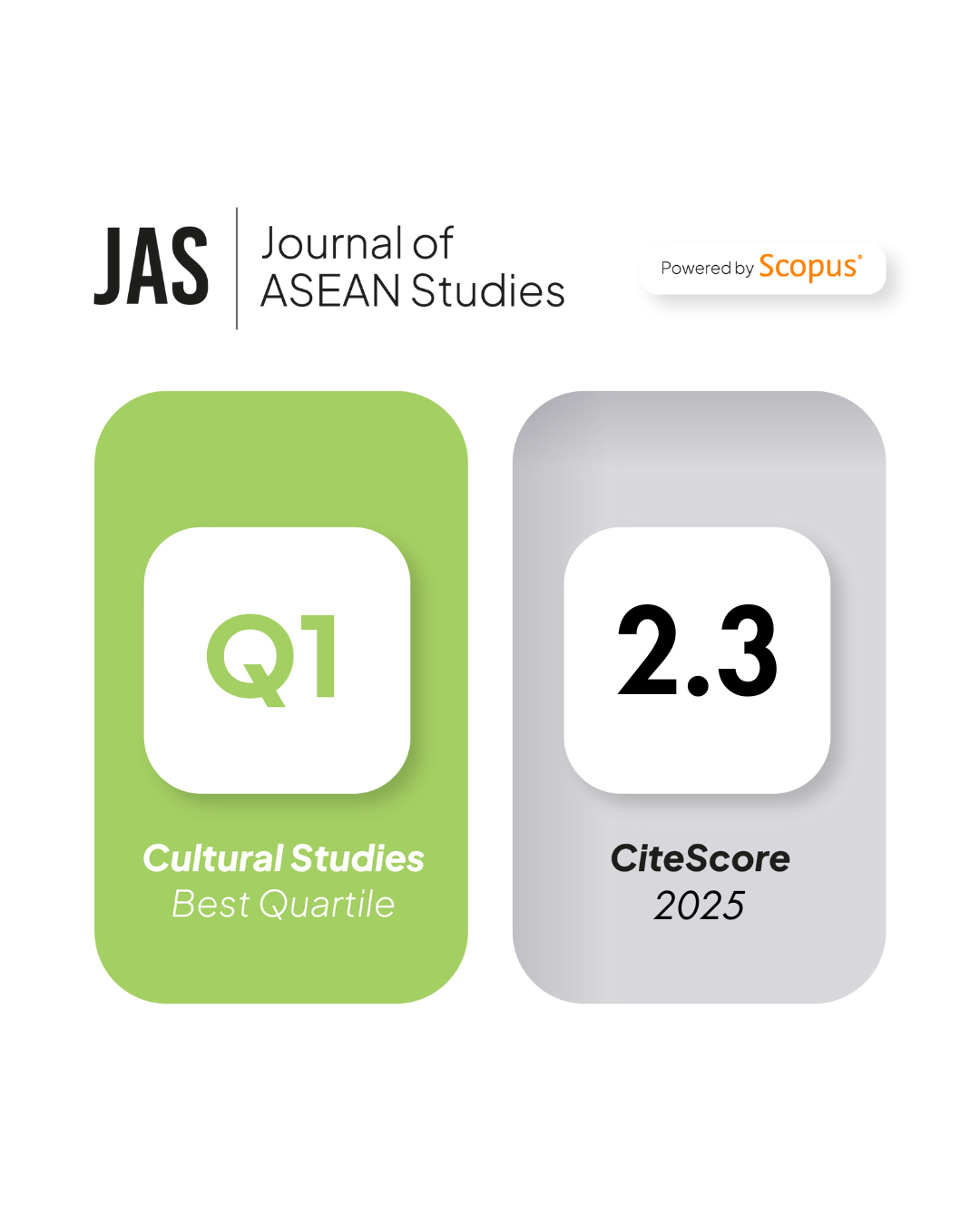The Mandala Culture of Anarchy: The Pre-Colonial Southeast Asian International Society
DOI:
https://doi.org/10.21512/jas.v1i1.764Keywords:
Pre-Colonial History, Southeast Asia, Mandala, Tributary SystemAbstract
Throughout the years, study on pre-colonial Southeast Asian international relations has not garnered major attention because it had long been seen as an integral part of the China-centred tribute system. There is a need to provide greater understanding of the uniqueness of the international system as different regions have different ontologies to comprehend its dynamics and structures. This paper contributes to the pre-colonial Southeast Asian literature by examining the interplay that had existed between pre-colonial Southeast Asian empires and the hierarchical East Asian international society, in particular during the 13th-16th Century. The paper argues that Southeast Asian international relations in pre-colonial time were characterized by complex political structures with the influence of Mandala values. In that structural context, the Majapahit Empire, one of the biggest empires at that time had its own constitutional structures of an international society, albeit still sought close relations with China.
References
Acharya, A 2003, “Will Asia’s Past Be Its Future?â€,International Security, vol.28, no. 3, pp. 149-164.
Boesche, R 2003, Kautilya’sArthaÅ›Ästra on War and Diplomacy in Ancient India, Journal of Mili¬tary History, vol. 67, no. 1, pp. 9–37.
Bull, H & Watson, A (eds) 1984, The Expansion of International Society, Oxford University Press, Oxford.
Dellios, R 2003, “Mandala: From Sacred Origins to Sovereign Affairs in Traditional Southeast Asiaâ€, CEWCES Research Paper, no. 10.
Evans, G & Newnham, J 1998, The Penguin Dictionary of International Relations, Penguin Group, London.
Flawith, RW 2011, “The Regressing ‘Culture of Anarchy’ in Ancient China and its Implications for Wendt’s Progressive Constructivismâ€, Australian Journal of International Affairs, vol. 65, no. 3, pp. 263-282.
Gesick, L 1983, 'Introduction', in L Gesick (ed), Centres, Symbols, and Hierarchies: Essays on the Classical States of Southeast Asia, Monograph No. 26, Yale University Southeast Asia Studies, NewHaven, Connecticut, pp. 1-8.
Goh, E 2009, ‘Hegemony, Hierarchy, and Order’, in WT Tow (ed), Security Politics in the Asia Pacific: A Regional-Global Nexus?,Cambridge University Press, Cambridge, pp. 101-121.
Grey, M 2001, “Encountering the Mandala: The Mental and Political Architectures of Dependencyâ€, The Culture Mandala, vol. 4, no. 2, pp. 1-13.
Kang, D 2007, China Rising: Peace, Power, and Order in East Asia, Columbia University Press, New York, Chapter 4 ‘Hierarchy and Stability in Asian International Relations’.
Kang, D 2010, East Asia before the West: Five Centuries of Trade and Tribute,Columbia University Press, New York.
Koslowski, R &Kratochwil, FV 1994, ‘Understanding Change in International Politics: the Soviet Empire’s Demise and the International System‘, International Organization, The MIT Press, Massachusetts
Laichen, S 2010, ‘Assesing the Ming Role in China’s Southern Expansion’, in G Wade & S Laichen (eds), Southeast Asia in the Fifteenth Century: The China Factor, National University of Singapore Press, Singapore, pp. 44-79.
Lake, D 2009, Hierarchy in International Relations, Cornell University Press, Ithaca and London, Chapter 2 ’International Hierarchy’.
Lieberman, V 1993, “Local Integration and Eurasian Analogies: Structuring Southeast Asian History, c. 1350 -- c. 1830â€, Modern Asian Studies, vol. 27, no. 3, pp. 475-572.
Munandar, AA 2008, Ibu kota Majapahit, Masa Jaya danPencapaian (The Majapahit Capital, its Golden Age and Achievements), KomunitasBambu, Depok.
Peng Er, L and Teo, V (eds) 2012, Southeast Asia Between China and Japan, Cambridge Scholars Publishing, Newcastle.
Pramono, S 2010, “Negara Nusantara and Her Regional Architectureâ€, paper presented in seminar titled “The Emerging Powers and Global Governanceâ€, held by China Centre for Contemporary World Studies and Rosa Luxemburg Foundation of Germany in Beijing.
Purwadi, DR 2004, JejakNasionalisme Gajah Mada (Gajah Mada’s Nationalism), Diva Press, Jogjakarta.
Reus Smit, C 1999, The moral purpose of the state, Princeton University Press, Princeton.
Reynolds, CJ 2008, Early Southeast Asia: Selected Essays O.W. Wolters, Cornell University, Ithaca.
Rother, S 2012, “Wendt Meets East: ASEAN Cultures of Conflict and Cooperationâ€, Cooperation and Conflict, vol.47, no. 1, pp. 49-67.
Sardesai, DR 2010, Southeast Asia Past and Present: Sixth Edition, Westview Press, Colorado.
Shu, M 2012a, “Balancing in a Hierarchical System: Pre-Colonial Southest Asia and the Tribute Systemâ€, WasedaGlobal Forum, no. 8, pp. 1-30.
Shu, M 2012b, “Hegemon and Instability: Pre-Colonial Southeast Asia under theTribute Systemâ€, WIAS Research Bulletin, no. 4, pp. 45-62.
Slametmuljana 1976, A Story of Majapahit, Singapore University Press, Singapore
Slametmuljana 2006, Negara Kretagama, LkiS, Jogjakarta.
Suzuki, S 2009, Civilization and Empire: China and Japan’s Encounter with European International Society, Routledge, London and New York, Chapter 2 ‘The East Asian International Society’.
Tucci, G 1961, The Theory and Practice of the Mandala, Rider & Co, London.
Wade, G 2010, ‘Southeast Asia in the 15th Century’, in G Wade & S Laichen (eds), Southeast Asia in the Fifteenth Century: The China Factor, National University of Singapore Press, Singapore, pp. 3-43.
Wang, G 1968, ‘Early Ming Relations with Southeast Asia: A Background Essay’, in JK, Fairbank (ed), The Chinese World Order: Traditional China’s ForeignRelations, Harvard University Press, Cambridge, pp. 34-62.
Waltz, KN 1979, Theory of International Politics, Addison-Wesley, Reading.
Wendt, A 1992, “Anarchy is what states make of itâ€. International Organization, vol.46, no. 2, pp. 379–396.
Wendt, A 1999, Social Theory of International Politics, Cambridge University Press, Cambridge.
Wolters, OW 1968, ‘Ayudhya and the Rearward Part of the World’, Journal of theRoyal Asiatic Society, no. 3 & 4, pp. 166-78.
Wolters, OW 1999, History, Culture and Religion in Southeast Asian Perspectives Revised edition, Southeast Asia Program Publications (SEAP) in cooperation with The Institute of Southeast Asian Studies (ISEAS), Ithaca & Singapore.





















